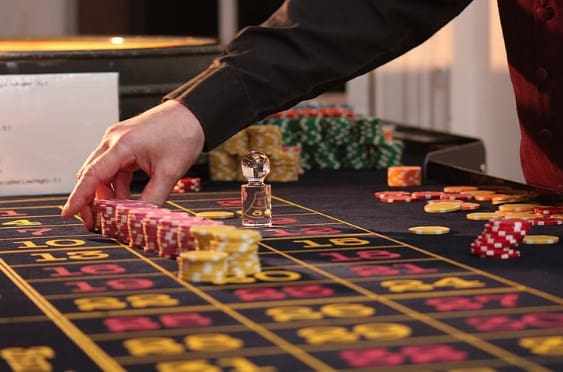While we all know that a coin flip will result in either heads or tails, it doesn’t mean you can flip “heads” and then flip “tails.” Because each flip is independent of previous flips and past flips do not have any bearing on future events, this is important. If you flip 100 heads consecutively, your chances of getting the next coin to come charges are still 50/50. This is why we can see trends happening around us. We don’t know how they will continue or why they occur. We do know that trends happen.
You’ve probably seen a trend happen at a casino. Maybe it was at the craps tables with a hot shot that hit one number after another. Perhaps it was at the Roulette table, where you saw ten consecutive red numbers. Depending on which side you’re on, trends can be very beneficial or very detrimental. Professional gamblers will tell a player to look for trends and not bet against them. If 10 of the ten numbers on a roulette table are all red, don’t think, “Oh, look, there are ten red numbers in succession; black is coming soon!” Instead, think about: “Oh, look, there’s a trend; let’s ride it out until it dies!” Keep in mind that each event is an independent entity.
This is a common misconception. Casinos have “Spin History” boards on all their roulette tables. This encourages people to wager against the trends rather than with them and has resulted in casinos seeing their profits rise at the roulette tables. Hot trends are a casino’s worst nightmare. You should always look out for trends and capitalize on them. This is done by “charting” the tables. Chart the tables until you spot a trend. Make sure you know what game you’re playing to make the right bets to profit from the trend.
But be careful. Remember the most important aspect of gambling: Discipline. It’s one thing to spot a trend and get in on it. Recognizing when a trend is over and telling your clients it’s time for you to move on is another. It is difficult for many people to leave the table when they are ahead or behind. It is essential to establish win goals and loss limits. It’s better to leave the table with some cash than to go home empty-handed. Never chase your losses!
Professional gambling is possible by following the trends. This simple concept is only one. Many factors go into it. Find your trend by charting the casino tables. You can take advantage of the trend by learning proper betting techniques at each game. You must practice discipline and intelligent money management not to walk away from a trend. Good luck!
Although Roulette was invented in France in the 16th century, it became a popular game of chance in America. European Roulette, the most well-known and popular version of Roulette today, is the Old World version. American Roulette was developed later than its European counterpart and had minor differences. Slotland Casino also offers online Roulette and poker.
The European game features a central character: a wheel upon which the dealer or croupier throws the ball and a table where all players place bets. The roulette wheel’s perimeter is engraved with numbers ranging from 1 to 36. Each numeral can be either black or red. This creates equal numbers of blacks and whites, odd and even numbers, as well as high (18–36) and low (1-17). There is one green slot that bears the number zero, in addition to 36 slots numbered.
A single green zero slot gives the ball the possibility to land on the 37th slot of the roulette wheel. Because it includes a low house edge, the green place is sometimes called the “house number.” If a player bets on “black” or red, the odds of the ball landing on red or black would be 50/50. These odds would be the same as flipping a coin to determine if it is heads or tails. This makes the chances of the ball landing on red or black slightly lower than 50/50. Because of the random movement, all bets on red or black will lose due to the casino or house. The casino has a 2.70% advantage when playing European Roulette.
American Roulette is the same game as European Roulette. However, there’s one crucial difference. The “double zero” (or “00”) is an additional green slot on the wheel. There are 38 probable slots where the ball can land. This almost duplicated the house edge, to 5.26%, compared to the European version. While players stand to lose more, they also get a quicker game.
Another quirk exists in the European roulette strategy. Players have the option to use “en prison” rules. If zero appears, the player can leave the game or surrender half of their “outside” wagers.
The European Roulette house edge drops to 1.352 percent from 2.7% when you add the “Surrender” option. This makes European Roulette more profitable than the 5.26% in the United States.
Are you among the millions of poker players? I can confirm that I am one of them. Perhaps you’re like me, who fell in love with poker after watching “Rounders.” The movie was great. I loved the twists and turns that Matt Damon gave poker. Slotland is sure that you will love playing either American Roulette or European Roulette. You might be a fan of casino games and are looking to make some money by playing most casino games. No matter what your motivation, I’m sure you’re here because you want to learn to play poker. This card game is a tried and true classic that was one of the first to be invented. You need to be able to tell when to hold ’em and fold ’em before spending your entire life savings on poker. Learn five simple steps to master poker.
Learn the value of each card and how they are calculated
Poker can be played using a standard 52-card deck. The cards are ranked in the following order: Ace, King, Queen, Jack, 10, 9, 8/7, 7, 6, 5, 4, 3. You can also break down the cards into four types: hearts, hearts, spades, and diamonds. Each player gets five cards. Each player is dealt five cards.
From worst to best, the following order is used for ranking hands:
- Royal Flush
- Straight Flush
- Full House
- Flush
- Straight
- Flush
- Straight
- Two Pair
- High Card
Learn the basics of the game
Without further poker knowledge, we don’t feel confident releasing you to card sharks. After you have learned the values of the cards, it is time to master the basics of poker. It is essential to understand when to place an ante or token wager. Knowing how many cards the dealer will first offer you is crucial. It is necessary to know when you should open, check, see and raise, and when to fold. Knowing when you should draw another card or throw it down is essential. It would benefit if you understood how to win and how you can be that person. We will share strategies and information on achieving this in the following articles.
Learn the lingo
To fully understand poker and not get beat up by other players, you need to learn the language of the game. Learn the following terms: bluff; aggressive play; conservative play; action and tell. These are the most commonly used terms in poker.
Tell your poker enemy what you “tell” him
You can inadvertently give clues when you lie. A “tell” refers to a way of speaking that you accidentally repeat, allowing other players to see how good or poor your hand is. Although no one wants others to know their “tell,” everyone does. One player might smudge his forehead when he has a solid hand to control excitement. One player might grit his teeth when he has a soft hand. This is a nervous reaction to her upcoming bluff. It doesn’t matter what it is; you should always look for clues from other players and try to conceal yours.
Be smart
Although it may seem like an absurdity to be smart about betting, there are ways you can minimize your losses and maximize your winnings at the poker table. A good poker player can win even with bad cards if he can correctly place his bets. While poker can be fun, some people lose control and get out of control. Some people might have drunk too much or bet too high on a possible win. People also place bets that are higher than they can afford. Before you get involved in any gambling, learning some money management skills is a good idea.
Poker is, in its essence, a simple game. The many poker variations can complicate it, so you should learn one type before moving on to the next. These five measures are all you need to know about poker. You can also practice low or no-risk poker. If you’re starting, finding a poker practice area is essential. Online sites offering low stakes or free bets are available.
Poker, a tantalizing blend of skill, strategy, and a sprinkle of luck, transcends being merely a card game. It’s a nuanced art form, intertwining psychological insight with a keen sense of probability and risk management. Distinct from other casino games, poker pits you not against the unfeeling house, but against fellow players, weaving a rich tapestry of strategy and human interaction.
Cultivating a Multidimensional Strategy
The essence of poker lies in its strategic depth. It demands adaptability: what works in one hand might falter in the next. The palette of play styles – ranging from the cautious tightness, the looseness of risk, to the assertive aggression, and the measured passivity – must be masterfully employed. Seasoned players fluidly switch these styles, reading the room, adapting to the unfolding drama, capitalizing on opponents’ vulnerabilities.
Bluffing: A Subtle Art
Bluffing, in poker, is akin to a delicate dance. It’s far more than mere deception; it’s about weaving a believable narrative. This intricate art requires an intimate understanding of the psychological play at hand – it’s not just the cards you hold but the story you tell. Timing, conviction, and the ability to discern the unspoken thoughts of your opponents are the cornerstones of a successful bluff. Yet, tread cautiously, for overuse or predictability in bluffing can lead to your undoing.
Deciphering Your Opponents
A critical aspect of poker is the ability to ‘read’ opponents. This skill, honed over time, involves noticing subtle physical cues, recognizing betting patterns, and sensing shifts in behavior. Understanding an adversary’s style is a powerful weapon; it enables you to anticipate moves, sway decisions, and turn weaknesses into opportunities.
Prudent Bankroll Management
In the realm of gambling, effective management of your bankroll is paramount. It’s a balance of ambition and restraint. Set yourself limits and adhere to them with unwavering discipline. Remember, the true gambler’s victory lies not in sporadic windfalls but in the ability to stay in the game, to keep playing.
Evolving with the Game
Poker is ever-changing, a game in constant flux. Yesterday’s strategies may falter today. The most adept players are those in perpetual pursuit of learning, adapting their play to new trends and strategies. In poker, complacency is the enemy of success.
Concluding Thoughts
Poker is an intricate dance of chance, skill, and psychology. Initially daunting, it unfolds as a path of continual learning. Each hand dealt is not just a game but a lesson. Win or lose, there is always wisdom to be gleaned. Immerse yourself in the study of the game, practice relentlessly, but above all, relish the journey. Remember, as the adage goes, poker is a game that takes a day to learn but a lifetime to master. Here’s to the journey – may it be as rewarding as the destination. Happy playing!


